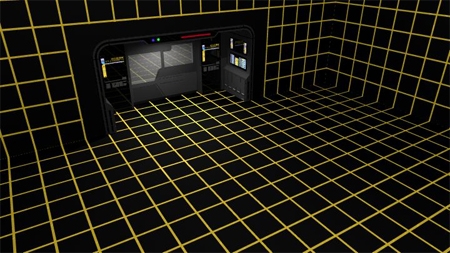
Putting the “Science” in “Science Fiction” – The Holodeck
I discussed the potential future uses of holograms in my last blog. Although holograms have many uses in prototyping, communications and medical treatment, it is likely that mass-produced holographic technology would be mainly used for entertainment. The ultimate expression of this idea is the holodeck from the Star Trek series. This chamber uses a combination of holograms and matter replication to create a simulated environment that seems totally real to the people interacting with it. In order to create totally realistic holograms, the holodeck creates holograms by holding photons inside of force fields, simulating contact with solid objects by strengthening the force field. Since neither force fields nor matter replication are within current technology, it is impossible for us to build true holodecks at the present time. However, as with many science fiction technologies, the difficulty of the task has not stopped people from attempting to create a similar experience with the technology that is currently available.

(Photo Credit: trek.fm)
With modern computing technology and the advancements that are currently being made with motion tracking and projection technologies, it is not difficult to simulate an environment to a certain extent – this as can be seen in a series of astounding videos that were created using simple PlayStation 3 hardware and a series of projectors. Some props are used to provide real objects for the actors to interact with, but the use of computer projections to create all the colors and textures shows the possibilities of easily available technologies when used in creative ways. Although it is not capable of creating three-dimensional figures, these PlayStation 3 videos show how simple projectors can create the illusion of 3D backgrounds, as well as the illusion of objects.

(Photo Credit: evl.uic.edu)
A similar technology is currently being used by the University of Illinois, as it develops the CAVE2 system – a 320-degree ring of 3D television screens that are linked to the same program. The user wears a pair of 3D glasses and carries a control device: both are studded with location points. The system tracks these points to show where the user’s head and hands are pointing and uses this information to change what is displayed. This allows the user to interact with the objects displayed on the television screens while modifying the view to match the orientation of the user’s head. Although the creators foresee this technology being used in the automotive, architectural and medical fields, it would also have great promise in the entertainment field if it were not for the expense in creating it.
There are many ways to attempt to imitate the holodeck experience, and Project Holodeck is taking a different path from the others by focusing attention on the use of the Oculus Rift virtual reality headset in order to create an immersive experience. Although this system does not use holograms, it does use an advanced motion-tracking system. This allows the display in the headset to reorient itself to the user’s movements, but what is more impressive is that it feeds this information into the simulation itself. The system tracks the user’s arm, leg and body movements and recreates them in the

simulation, so that as the user moves his limbs, his avatar in the game does as well. Multiple users can be connected at one time and they can each see the other’s avatars imitating the movements in real time of their real-world selves. If true holographic technology becomes readily available, this system could be used to allow a hologram to follow a person’s movements, enabling him to look like whatever he wants by creating holographic clothing, or even making the user look like another person or creature entirely.
Although none of these technologies can match the versatility or realism of the holodeck, they are all steps in the right direction, and as new technologies are discovered and integrated together, the ability to create a fully interactive simulated environment will get closer and closer.
Top Photo: thescrib.com









